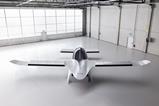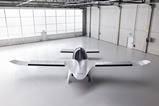Deutsche Aircraft is preparing to cut metal on its first D320eco test aircraft as the German manufacturer maintains its pace towards a 2025 first flight.
Based on the original Dornier 328 twin-turboprop, the D328eco is a 2m (6ft 7in) stretch that increases the accommodation to up to 43 passengers. It also features new Pratt & Whitney Canada PW127XT-S engines and a Garmin G5000 avionics suite.

For the test aircraft, Deutsche Aircraft is using a zero-hour fuselage and wing retained from the earlier programme, for which it is the type certificate holder.
However, in order extend the fuselage, the airframer will add a single fuselage plug, in a change from previous plans to add two smaller plugs.
“We will make two cuts rather than four cuts,” says chief executive Dave Jackson. A maiden sortie for the modified aircraft is planned for the third quarter of 2025, he adds.
Around 95% of the supply chain for the D328eco is now locked down, Jackson says, including the primary structures, engines, landing gear, avionics and nacelles.
Service entry for the D328eco is expected in the second half of 2026. Deutsche Aircraft last year secured its first customer for the type – a five-unit commitment from Germany-based Private Wings – and Jackson says it is talking to another 40 operators for a combined total of around 400 aircraft.
In order to achieve its environmental goals, Deutsche Aircraft intends the D328eco to be 100% sustainable aviation fuel (SAF) compatible at service entry.
But the company is also contributing to advancing knowledge in the space having delivered a Do 328 test aircraft to Germany’s DLR aerospace research agency for its Uplift programme.
That aircraft (D-CUPL) recently carried out a 2h-plus test flight from Deutsche Aircraft’s Oberpfaffenhofen base powered entirely by a power-to-liquid (PTL) proxy fuel. It was subsequently ferried to Berlin where it is on display at the 5-9 June ILA show.
Further tests of PTL will take place using the Uplift aircraft, says Regina Pouzolz, the company’s sustainability director, as the DLR looks to better understand its environmental performance in a turboprop aircraft.
“I’m really very excited – the emission-measurement campaign run by the DLR will be the first time it has been done on a turboprop.
“We will really be filling a gap there on the ground and in the air. We expect the benefits to be huge but we don’t yet have any data to support this.”
Pouzolz says the expected CO2 emission saving from PTL fuel use is in the region of 95% over conventional jet fuel.
Nonetheless, Deutsche Aircraft continues to analyse the potential for a follow-on product to the D328eco, one potentially using hydrogen power – either for direct combustion or to run fuel cells.
“We don’t know how step two will look yet but we know what the options will be,” says Jackson.
“We are looking at different hydrogen-based solutions but these aren’t realistic until the late 2030s or even the 2040s.”































